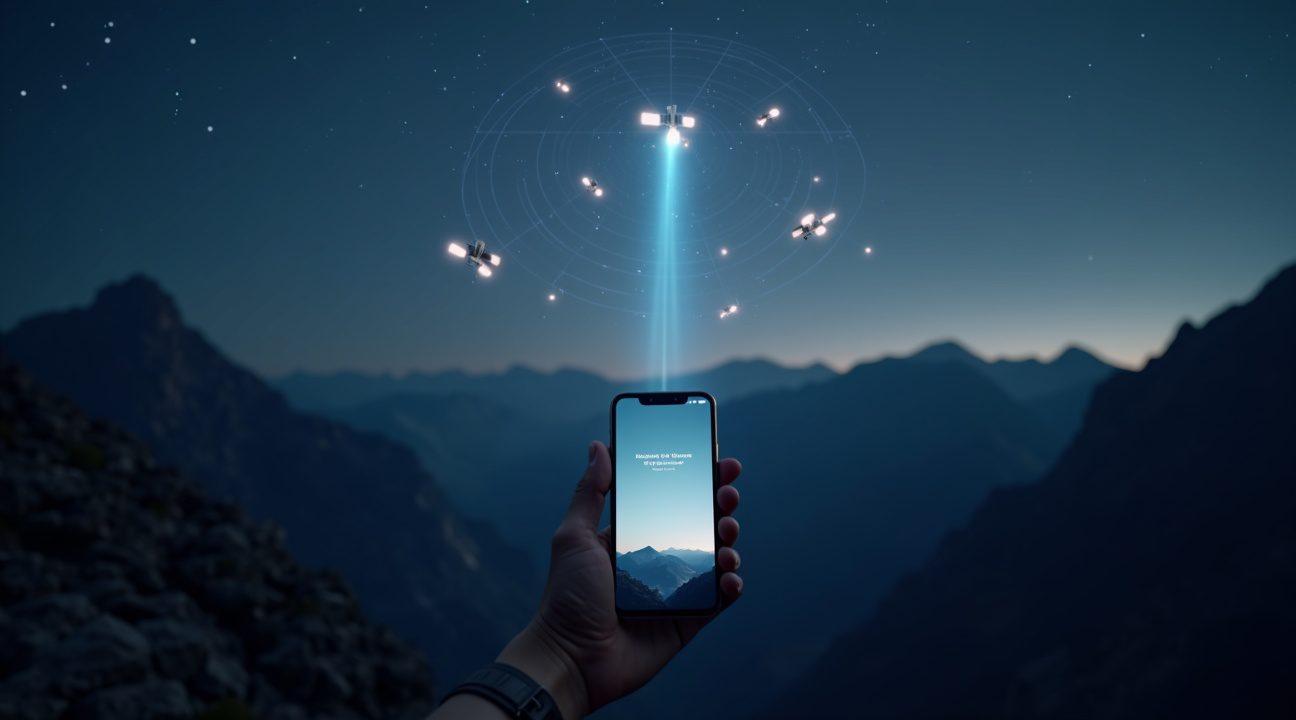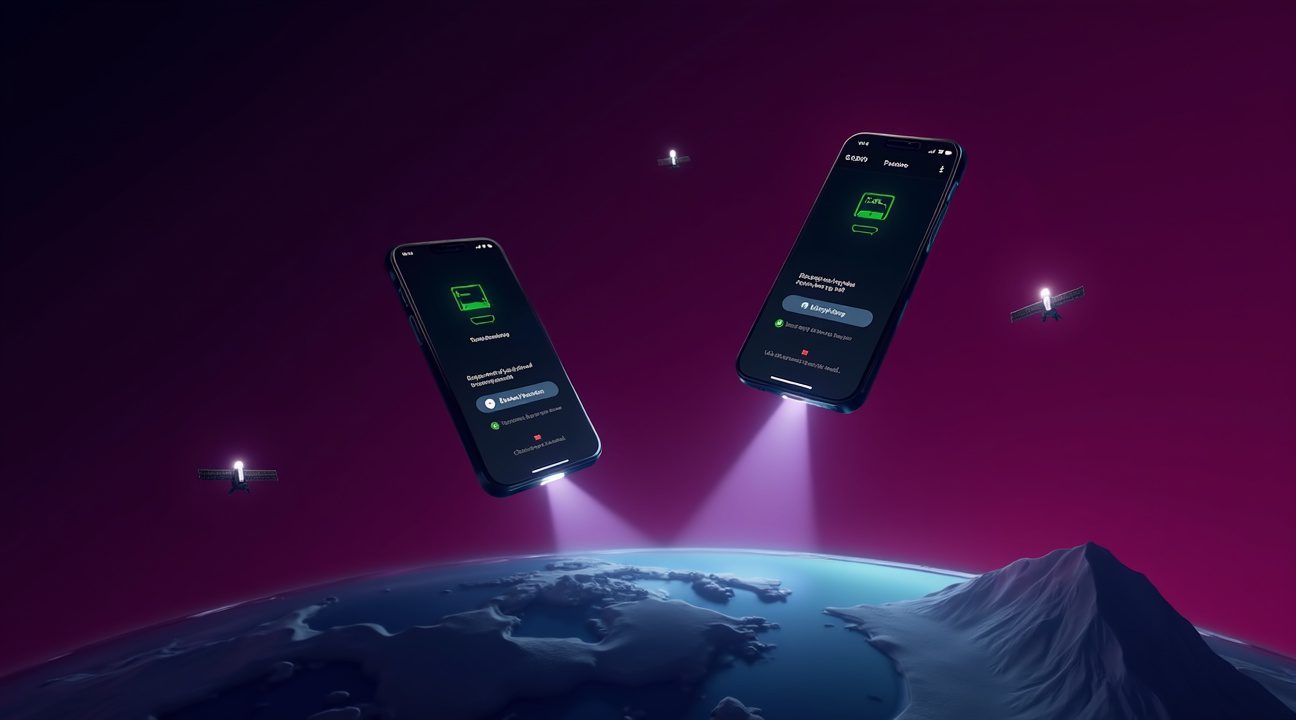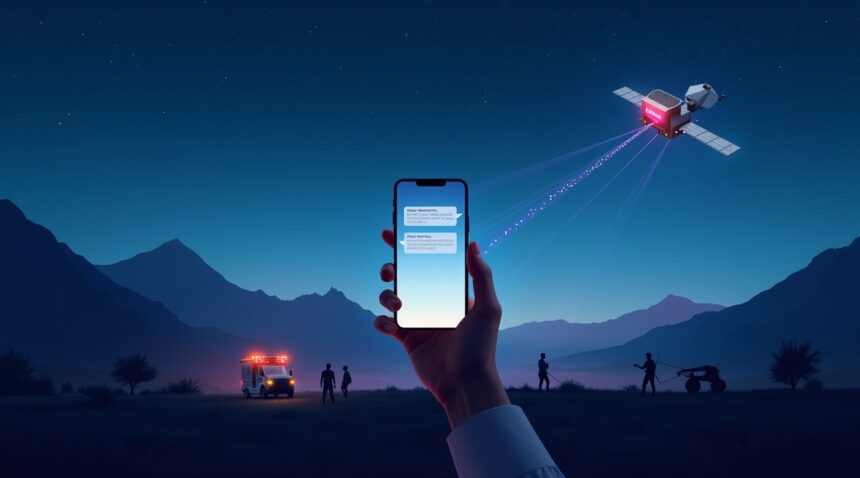T-Mobile officially launched its revolutionary Direct-to-Cell satellite service on July 23, 2025, in partnership with Starlink, marking a historic breakthrough in eliminating mobile dead zones across the United States.
Key Takeaways
- T-Mobile’s satellite service works on existing smartphones from all major carriers (T-Mobile, AT&T, Verizon) without requiring special equipment or apps
- The service costs $10 per month for most users, while T-Mobile premium plan customers receive it free as part of their existing service
- Initial launch focuses on satellite text messaging, with broadband and data features planned for October 2025 expansion
- Cross-network compatibility allows customers from competing carriers to access T-Mobile’s satellite connectivity during emergencies or in remote areas
- The technology utilizes over 657 specialized Starlink satellites to provide coverage in wilderness areas, rural communities, and regions affected by natural disasters
Transforming Telecom Infrastructure
The partnership between T-Mobile and Starlink represents a significant leap forward in telecommunications infrastructure. Standard smartphones now connect directly to satellites orbiting hundreds of miles above Earth. Users can send and receive text messages in areas where traditional cell towers cannot reach.
The beta testing phase demonstrated remarkable success rates. Participants sent messages from remote hiking trails, isolated cabins, and areas devastated by natural disasters. The service maintained consistent connectivity across diverse geographic conditions and weather patterns.
Universal Access and Emergency Capabilities
T-Mobile designed the system with universal compatibility in mind. Customers from competing wireless carriers can activate emergency messaging features through T-Mobile’s satellite network. This cross-carrier functionality ensures public safety during critical situations where traditional cellular infrastructure fails.
The pricing structure reflects T-Mobile’s strategy for widespread adoption. Premium plan subscribers automatically receive satellite messaging capabilities without additional fees. Standard customers pay $10 monthly for unlimited satellite text messaging access.
October 2025 Expansion Plans
October 2025 marks the next phase of service expansion. T-Mobile plans to introduce satellite-based data connectivity and limited internet browsing capabilities. These enhanced features will transform how people stay connected in remote locations.
The specialized Starlink satellites operate on modified frequencies specifically allocated for direct cellular communication. Each satellite maintains precise orbital positioning to ensure consistent coverage patterns across North American territories.
Benefits for Emergency Services and Rural Communities
Emergency responders have already begun integrating this technology into their communication protocols. The service provides backup connectivity during natural disasters when terrestrial networks become compromised or overloaded.
Remote work professionals now have reliable communication options in previously unreachable locations. The technology eliminates the need for expensive satellite phones or complex communication equipment for basic messaging needs.
The impact extends beyond individual users to entire communities in rural America. Small towns and isolated settlements gain access to emergency communication systems that previously required significant infrastructure investments.
Looking Ahead: Future Developments
Future developments include integration with existing messaging platforms and enhanced data transmission speeds. T-Mobile continues refining the technology based on real-world usage patterns and customer feedback from the ongoing deployment.
Satellite Texting Service Officially Launches July 23, 2025 with 1.8 Million Beta Participants
T-Mobile and Starlink made history on July 23, 2025, by officially launching their groundbreaking satellite service during a livestreamed event. This partnership marks a significant milestone in eliminating mobile dead zones across the United States through innovative direct-to-phone connectivity.
T-Satellite Launch Details and Features
The newly launched service, branded as T-Satellite, enables satellite-based direct-to-cell messaging as its primary feature. Users can now send and receive text messages even in the most remote locations where traditional cellular towers can’t reach. The company plans to expand capabilities further with a broadband and data feature scheduled for release in October 2025.
This satellite connectivity solution operates through Starlink’s extensive satellite constellation, creating an entirely new approach to mobile communications. The technology bridges the gap between terrestrial networks and space-based infrastructure, similar to how SpaceX has revolutionized space exploration.
Impressive Beta Performance and Cross-Network Compatibility
The beta phase demonstrated remarkable success with nearly 1.8 million participants actively testing the service from December 2024 through July 2025. These early adopters sent over one million messages during the testing period, proving the system’s reliability and user appeal.
Notably, the service functioned seamlessly across various U.S. networks, including:
- T-Mobile
- AT&T
- Verizon
This cross-network compatibility ensures that users from different carriers can benefit from satellite connectivity, regardless of their primary service provider. The interoperability represents a major advancement in telecommunications infrastructure.
The primary objective of this T-Mobile and Starlink partnership focuses on eliminating mobile dead zones nationwide. Rural areas, mountainous regions, and remote locations that previously suffered from poor or nonexistent cellular coverage now have access to reliable communication services. Emergency responders, outdoor enthusiasts, and people living in underserved areas will particularly benefit from this technology.
The satellite service utilizes Starlink’s low Earth orbit constellation to provide direct-to-phone connectivity without requiring specialized equipment or modifications to existing smartphones. Users simply need to have compatible devices and service plans to access the satellite messaging capabilities.
The October 2025 broadband feature expansion will transform how people stay connected in remote areas. This development could impact various industries, including:
- Agriculture
- Logistics
- Emergency services
- Tourism
The technology represents a fundamental shift in mobile communications infrastructure, positioning T-Mobile as a leader in next-generation connectivity solutions.

How Your Current Smartphone Works With Satellite Coverage Without Special Hardware
T-Mobile’s new direct-to-cell connectivity transforms any standard smartphone into a satellite communication device without requiring additional equipment. Most smartphones manufactured within the last four years can send and receive text messages through Starlink satellites when traditional cellular towers aren’t available. This breakthrough eliminates the need for specialized satellite phones or bulky external antennas that previously defined satellite communication.
The T-Satellite beta service operates through more than 657 Starlink satellites specifically equipped for direct cellular communication. These satellites work in coordination with T-Mobile’s existing spectrum allocation, creating a seamless bridge between space-based infrastructure and terrestrial mobile networks. Users don’t need to download special apps or modify their device settings—the service integrates directly with standard messaging applications.
Compatible Devices and Coverage Capabilities
The satellite constellation recognizes compatible devices automatically when they move outside traditional cellular coverage areas. Modern smartphones contain the necessary radio components to communicate with these specialized Starlink satellites, though the connection operates at lower data speeds compared to standard 5G networks. Text messaging receives priority in the current implementation, ensuring reliable communication for essential correspondence.
Coverage extends to remote locations where cellular towers can’t reach, including:
- Wilderness areas
- Rural communities
- Regions affected by natural disasters
The service fills critical communication gaps that have historically left users completely disconnected from mobile networks. Emergency responders and outdoor enthusiasts particularly benefit from this extended reach, as the satellite network provides backup communication when traditional infrastructure fails.
Free 911 text message support will launch later in 2025 for compatible devices, dramatically expanding emergency service coverage into previously unreachable areas. This enhancement addresses a significant safety concern for people traveling through remote regions where voice calls to emergency services weren’t possible. The SpaceX technology behind this capability represents a major advancement in emergency communication infrastructure.
The direct-to-cell technology leverages existing smartphone antennas and processing power rather than requiring specialized hardware modifications. Satellites communicate using the same frequency bands that smartphones already support, though they must overcome significantly greater distances and atmospheric interference. Signal processing algorithms compensate for the satellite’s rapid movement across the sky, maintaining stable connections as devices track multiple satellites simultaneously.
Battery consumption remains comparable to normal cellular usage since smartphones don’t need to boost transmission power significantly. The satellites’ advanced receivers can detect relatively weak signals from standard mobile devices, minimizing the power requirements for successful communication. This efficiency ensures that emergency situations don’t drain device batteries faster than normal usage patterns.
T-Satellite beta testing continues expanding coverage and refining connection reliability across different geographic regions. Early users report successful text message delivery in areas where cellular service previously required driving several miles to find signal coverage. The service automatically activates when smartphones detect the absence of traditional cellular networks, providing a seamless transition to satellite communication.
Device compatibility extends across multiple manufacturers and operating systems, though specific models may vary in their satellite communication effectiveness. Recent iPhone and Android devices generally support the required frequency bands and antenna configurations needed for direct-to-cell connectivity. Advanced signal processing helps optimize connections based on each device’s individual capabilities and current satellite positions.
The satellite constellation maintains global coverage through carefully orchestrated orbital patterns that ensure multiple satellites remain visible from any location on Earth. This redundancy prevents communication blackouts when individual satellites move beyond the horizon or experience technical issues. Ground-based coordination systems manage connection handoffs between satellites, maintaining message delivery even as the constellation continuously moves overhead.

T-Mobile Satellite Service Pricing: Free for Premium Plans, $10 for Others
T-Mobile’s satellite messaging service comes with straightforward pricing that benefits existing premium customers while remaining accessible to everyone else. The carrier has structured its satellite service costs to reward loyalty while keeping the technology affordable for broader adoption.
Premium T-Mobile subscribers enjoy the biggest advantage with this new service. Customers enrolled in the Experience Beyond or Go5G Next plans receive satellite messaging capabilities at no additional cost. These premium plans start at $17 per month for three lines, making the included satellite access an attractive value proposition for families or groups sharing service.
Pricing Structure for All Carriers
For customers outside T-Mobile’s premium tier, the satellite service costs $10 per month. This pricing applies to regular T-Mobile subscribers as well as users on competing networks like AT&T or Verizon. The monthly fee structure makes the service accessible without requiring significant upfront investment.
The subscription model operates on a month-to-month basis with no long-term contracts required. Users can cancel their satellite service subscription at any time through the T-Mobile app, providing flexibility that many consumers value. Monthly renewals happen automatically unless customers choose to discontinue the service.
T-Mobile has integrated the satellite service billing into existing platforms, allowing for easy bundling with current wireless plans. This integration simplifies account management for existing customers who want to add satellite capabilities to their service portfolio. The bundling option streamlines billing while maintaining transparency about satellite service costs.
The pricing strategy positions T-Mobile’s satellite offering competitively against traditional satellite communication devices, which often require higher monthly fees and longer commitment periods. By leveraging existing cellular infrastructure and SpaceX technology, T-Mobile can offer satellite connectivity at consumer-friendly prices.
Cross-carrier availability sets this service apart from typical carrier-exclusive features. Verizon and AT&T customers can access T-Mobile’s satellite messaging without switching their primary wireless service, creating an interesting dynamic where competitors’ customers become T-Mobile satellite subscribers.
The absence of contracts reflects broader industry trends moving away from long-term commitments. This flexibility appeals to consumers who may only need satellite connectivity seasonally or during specific activities like camping or traveling to remote areas.
For premium plan subscribers, the free satellite access adds significant value to already comprehensive service packages. The Experience Beyond and Go5G Next plans typically include enhanced data allowances, international features, and now satellite messaging capabilities.
The $10 monthly fee positions the service competitively against standalone satellite communicators, which often cost significantly more per month. Traditional satellite communication devices frequently require $30-50 monthly subscriptions along with expensive hardware purchases.
T-Mobile’s billing integration extends beyond simple cost bundling. Customers can monitor their satellite usage, manage settings, and adjust subscriptions through familiar interfaces. This integration reduces friction for users who want to add or remove satellite capabilities based on changing needs.
The pricing structure accommodates different usage patterns effectively. Occasional users can subscribe for specific months when satellite connectivity becomes necessary, while regular users benefit from consistent monthly access. Premium subscribers receive continuous coverage as part of their existing service commitment.
Payment processing follows T-Mobile’s standard billing cycles, with satellite service charges appearing alongside regular wireless fees. This consolidation simplifies expense tracking while maintaining clear itemization of satellite-specific costs. The integrated approach reduces administrative complexity for both individual and business customers managing multiple services.

T-Mobile Starlink vs Traditional Starlink Internet: Key Differences in Price and Purpose
I’ve observed a significant shift in satellite connectivity as T-Mobile’s partnership with SpaceX introduces a fundamentally different approach to satellite communication. The T-Mobile Starlink Direct-to-Cell service represents a departure from traditional satellite internet models, targeting mobile users with standard smartphones rather than fixed installations.
Service Design and Hardware Requirements
T-Mobile’s Direct-to-Cell technology eliminates the need for specialized equipment, allowing standard smartphones to connect directly via satellite in cellular dead zones. This contrasts sharply with traditional Starlink Residential Internet, which requires a dedicated kit containing an antenna, modem, and mounting hardware.
Traditional Starlink serves as a complete home internet replacement, delivering download speeds up to 300 Mbps for rural properties and RV users who lack reliable broadband access. The system functions as a fixed or portable internet solution, requiring professional or self-installation of the antenna system to establish connection.
T-Mobile’s approach focuses on filling coverage gaps in existing cellular networks, providing emergency messaging capabilities and future mobile data services without requiring users to purchase additional hardware or modify their current devices.
Pricing Structure and Value Proposition
The pricing models reflect each service’s distinct purpose and target audience:
- T-Mobile Starlink costs $10 monthly as an add-on service or comes complimentary with premium T-Mobile 5G wireless plans. This price point makes satellite connectivity accessible to mainstream mobile users who occasionally travel through areas with limited cellular coverage.
- Traditional Starlink Residential presents a different cost structure, starting at $80 monthly and potentially reaching $165 depending on the chosen plan and data requirements. This pricing includes the satellite internet service but requires an additional upfront investment in the Starlink kit, which typically costs several hundred dollars.
The comparison reveals two distinct value propositions:
- T-Mobile offers affordable backup connectivity for standard mobile use.
- Traditional Starlink provides comprehensive internet replacement for homes and businesses in underserved areas.
Traditional Starlink customers typically rely on the service as their primary internet connection, justifying the higher monthly cost through consistent high-speed access.
T-Mobile’s Direct-to-Cell primarily serves U.S. mobile dead zones, focusing on emergency communications and basic connectivity when terrestrial towers aren’t available. This targeted approach makes the service valuable for travelers, outdoor enthusiasts, and residents in areas with spotty cellular coverage who don’t require full-time satellite internet.
The fundamental difference lies in application scope: traditional Starlink replaces existing internet infrastructure, while T-Mobile Starlink supplements existing cellular networks. Traditional Starlink users often live in rural locations where fiber or cable internet isn’t available, making satellite their best option for reliable broadband access.
T-Mobile’s service appeals to users who maintain primary cellular service but want assurance of connectivity during emergencies or travel. The integration with existing T-Mobile plans simplifies billing and device management, as users don’t need to manage separate satellite internet accounts or equipment.
Technology advancement has enabled both services to coexist by serving different market segments effectively. Traditional Starlink continues evolving its residential and mobile offerings, while T-Mobile focuses on seamless integration with standard mobile devices and existing cellular plans.
https://www.youtube.com/watch?v=tLZzOX5TH8I
Industry-First Cross-Network Service Opens New Era of Universal Coverage
T-Mobile’s groundbreaking partnership with Starlink marks a historic milestone in telecommunications, delivering the first large-scale direct-to-cell satellite texting service for mainstream U.S. consumers. This revolutionary approach fundamentally changes how Americans stay connected, especially in areas where traditional cellular towers can’t reach.
Breaking Down Network Barriers
The most remarkable aspect of this service involves its cross-network compatibility, allowing even AT&T and Verizon customers to access satellite connectivity during emergencies. This unprecedented cooperation between competing carriers demonstrates how space exploration technology can unite the telecommunications industry for public benefit. I’ve watched carriers compete fiercely for decades, but this collaboration prioritizes consumer safety over corporate rivalry.
The service operates by connecting smartphones directly to Starlink satellites without requiring specialized hardware or apps. When cellular towers become unavailable due to natural disasters, remote locations, or network outages, users can still send text messages through satellite connections. This capability proves invaluable for emergency responders, outdoor enthusiasts, and anyone traveling through rural America.
Regulatory Challenges and Spectrum Wars
Behind the scenes, SpaceX actively campaigns for additional spectrum rights from the FCC, seeking to expand service capabilities beyond basic texting. However, established satellite operators like EchoStar oppose these requests, creating significant regulatory friction that could impact future service expansion. The competition illustrates how traditional satellite companies view Starlink’s rapid growth as a threat to their established business models.
The regulatory landscape remains complex, with various stakeholders arguing over spectrum allocation and interference concerns. These discussions will likely shape how quickly T-Mobile can enhance service offerings, potentially adding voice calls and data transmission capabilities to their satellite connectivity portfolio.
Enhanced public safety represents the primary value proposition for this cross-network service. Emergency access in dead zones could save lives during natural disasters, search and rescue operations, or medical emergencies in remote areas. Rural communities, which have historically struggled with reliable cellular coverage, stand to benefit significantly from this expanded connectivity option.
The service also offers tremendous convenience for outdoor enthusiasts who venture beyond traditional cellular coverage. Hikers, campers, and travelers can maintain basic communication capabilities without investing in expensive satellite phones or emergency beacons. This accessibility democratizes satellite communication, making it available to everyday consumers rather than just specialized professionals or emergency services.
Current limitations include text-only functionality and potential latency issues inherent to satellite communication. However, as artificial intelligence and satellite technology continue advancing, these constraints will likely diminish over time. The foundation established by this partnership creates opportunities for future enhancements that could revolutionize how Americans think about cellular connectivity and emergency preparedness.
Sources:
Broadband Breakfast, “T-Mobile and Starlink Satellite Service to Officially Launch July 23”
CNET, “T-Mobile Is Bringing Starlink to Your Phone Tomorrow. See If You’ll Get It for Free”
CNET, “T-Mobile and Starlink’s $10 a Month Satellite Texting…”
Alvarez Technology Group, “What Is T-Mobile Starlink Service? Overview, Features, and Availability”
CableTV.com, “T-Mobile vs. Starlink: Comparing Speeds, Pricing, Deals, and More”
HighSpeedInternet.com, “Starlink vs. T-Mobile Home Internet: Which Internet Provider Is Best…”
YouTube, Mobile Internet Resource Center, “The End of Cellular Deadzones T-Mobile Starlink TXT…”


